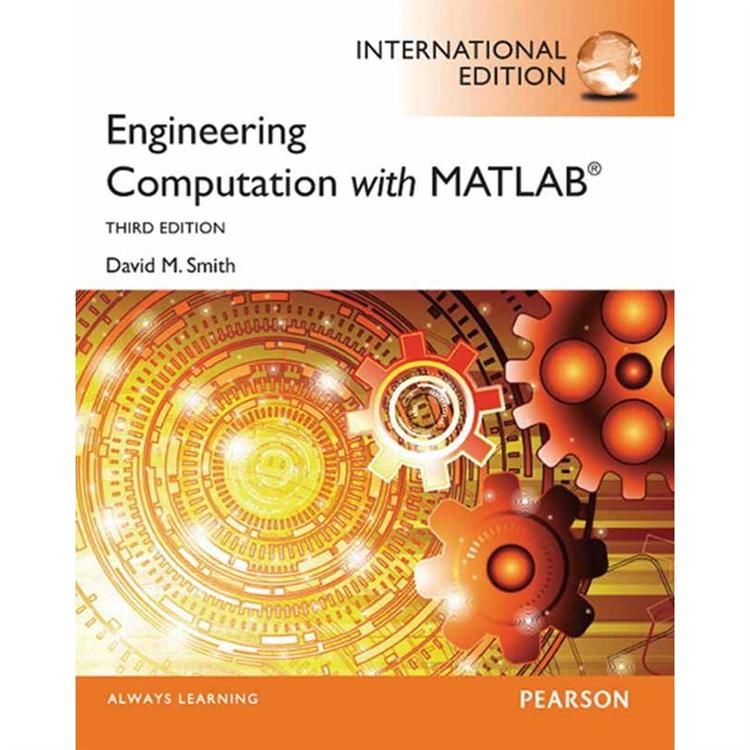1.1 Background
1.2 History of Computer Architectures
1.2.1 Babbage’s Difference Engine
1.2.2 Colossus
1.2.3 The von Neumann Architecture
1.3 Computing Systems Today
1.3.1 Computer Hardware
1.3.2 Computer Memory
1.3.3 Computer Software
1.3.4 Running a Computer Program
1.4 Running an Interpreted Program
1.5 Problem Solving
2.1 Programming Language Background
2.1.1 Abstraction
2.1.2 Algorithms
2.1.3 Programming Paradigms
2.2 Basic Data Manipulation
2.2.1 Starting and Stopping Matlab
2.2.2 Assigning Values to Variables
2.2.3 Data Typing
2.2.4 Classes and Objects
2.3 the Matlab User Interface
2.3.1 the Interactions Window
2.3.2 the Command History
2.3.3 the Variables Window
2.3.4 the Files Window
2.3.5 Editor Windows
2.3.6 Figure Windows
2.4 Scripts
2.4.1 Text Files
2.4.2 Creating Scripts
2.4.3 The Current Directory
2.4.4 Running Scripts
2.4.5 Punctuating Scripts
2.4.6 Debugging Scripts
2.5 Engineering Example— Spacecraft Launch
3.1 Concept: Using Built-in Functions
3.2 Concept: Data Collections
3.2.1 Data Abstraction
3.2.2 Homogeneous Collection
3.3 Vectors
3.3.1 Creating a Vector
3.3.2 Size of a Vector
3.3.3 Indexing a Vector
3.3.4 Shortening a Vector
3.3.5 Operating on Vectors
3.4 Engineering Example—Forces and Moments
3.5 Arrays
3.5.1 Properties of an Array
3.5.2 Creating an Array
3.5.3 Accessing Elements of an Array
3.5.4 Removing Elements of an Array
3.5.5 Operating on Arrays
3.6 Engineering Example—Computing Soil Volume
4.1 Concept: Code Blocks
4.2 Conditional Execution in General
4.3 if Statements
4.3.1 General Template
4.3.2 Matlab Implementation
4.3.3 Important Ideas
4.4 switch Statements
4.4.1 General Template
4.4.2 Matlab Implementation
4.5 Iteration in General
4.6 for Loops
4.6.1 General for Loop Template
4.6.2 Matlab Implementation
4.6.3 Indexing Implementation
4.6.4 Breaking a for Loop
4.7 while Loops
4.7.1 General while Template
4.7.2 Matlab while Loop Implementation
4.7.3 Loop-and-a-Half Implementation
4.7.4 Breaking a while Loop
4.8 Engineering Example—Computing Liquid Levels
5.1 Concepts: Abstraction and Encapsulation
5.2 Black Box View of a Function
5.3 Matlab Implementation
5.3.1 General Template
5.3.2 Function Definition
5.3.3 Storing and Using Functions
5.3.4 Calling Functions
5.3.5 Returning Multiple Results
5.3.6 Auxiliary Local Functions
5.3.7 Encapsulation in Matlab Functions
5.3.8 Global Variables
5.4 Engineering Example—Measuring a Solid Object
6.1 Character String Concepts: Mapping and Casting
6.2 Matlab Implementation
6.2.1 Slicing and Concatenating Strings
6.2.2 Arithmetic and Logical Operations
6.2.3 Useful Functions
6.3 Format Conversion Functions
6.3.1 Conversion from Numbers to Strings
6.3.2 Conversion from Strings to Numbers
6.4 Character String Operations
6.4.1 Simple Data Output: The disp(...) Function
6.4.2 Complex Output
6.4.3 Comparing Strings
6.5 Arrays of Strings
6.6 Engineering Example— Encryption
7.1 Concept: Collecting Dissimilar Objects
7.2 Cell Arrays
7.2.1 Creating Cell Arrays
7.2.2 Accessing Cell Arrays
7.2.3 Using Cell Arrays
7.2.4 Processing Cell Arrays
7.3 Structures
7.3.1 Constructing and Accessing One Structure
7.3.2 Constructor Functions
7.4 Structure Arrays
7.4.1 Constructing Cell Arrays
7.4.2 Accessing Structure Elements
7.4.3 Manipulating Structures
7.5 Engineering Example—Assembling a Structure
8.1 Concept: Serial Input and Output (I/O)
8.2 Workspace I/O
8.3 High-level I/O Functions
8.3.1 Exploration
8.3.2 Spreadsheets
8.3.3 Delimited Text Files
8.4 Low-level File I/O
8.4.1 Opening and Closing Files
8.4.2 Reading Text Files
8.4.3 Examples of Reading Text Files
8.4.4 Writing Text Files
8.5 Engineering Example— Spreadsheet Data
9.1 Concept:The Activation Stack
9.1.1 A Stack
9.1.2 Activation Stack
9.1.3 Function Instances
9.2 Recursion Defined
9.3 Implementing a Recursive Function
9.4 Exceptions
9.4.1 Historical Approaches
9.4.2 Generic Exception Implementation
9.4.3 Implementation
9.5 Wrapper Functions
9.6 Examples of Recursion
9.6.1 Detecting Palindromes
9.6.2 Fibonacci Series
9.6.3 Zeros of a Function
9.7 Engineering Example—Robot Arm Motion
10.1 Solving Simple Problems
10.2 Assembling Solution Steps
10.3 Summary of Operations
10.3.1 Basic Arithmetic Operations
10.3.2 Inserting into a Collection
10.3.3 Traversing a Collection
10.3.4 Building a Collection
10.3.5 Mapping a Collection
10.3.6 Filtering a Collection
10.3.7 Summarizing a Collection
10.3.8 Searching a Collection
10.3.9 Sorting a Collection
10.4 Solving Larger Problems
10.5 Engineering Example— Processing Geopolitical Data
11.1 Plotting in General
11.1.1 A Figure—The Plot Container
11.1.2 Simple Functions for Enhancing Plots
11.1.3 Multiple Plots on One Figure—Subplots
11.1.4 Manually Editing Plots
11.2 2-D Plotting
11.2.1 Simple Plots
11.2.2 Plot Options
11.2.3 Parametric Plots
11.2.4 Other 2-D Plot Capabilities
11.3 3-D Plotting
11.3.1 Linear 3-D Plots
11.3.2 Linear Parametric 3-D Plots
11.3.3 Other 3-D Plot Capabilities
11.4 Surface Plots
11.4.1 Basic Capabilities
11.4.2 Simple Exercises
11.4.3 3-D Parametric Surfaces
11.4.4 Bodies of Rotation
11.4.5 Other 3-D Surface Plot Capabilities
11.4.6 Assembling Compound Surfaces
11.5 Manipulating Plotted Data
11.6 Engineering Example—Visualizing Geographic Data
11.6.1 Analyzing the Data
11.6.2 Displaying the Data
12.1 Concept: Behavioral Abstraction
12.2 Matrix Operations
12.2.1 Matrix Multiplication
12.2.2 Matrix Division
12.2.3 Matrix Exponentiation
12.3 Implementation
12.3.1 Matrix Multiplication
12.3.2 Matrix Division
12.4 Rotating Coordinates
12.4.1 2-D Rotation
12.4.2 3-D Rotation
12.5 Solving Simultaneous Linear Equations
12.5.1 Intersecting Lines
12.5.2 Curve Fitting
12.6 Engineering Examples
12.6.1 Ceramic Composition
12.6.2 Analyzing an Electrical Circuit
13.1 Nature of an Image
13.2 Image Types
13.2.1 True Color Images
13.2.2 Gray Scale Images
13.2.3 Color Mapped Images
13.2.4 Preferred Image Format
13.3 Reading, Displaying, and Writing Images
13.4 Operating on Images
13.4.1 Stretching or Shrinking Images
13.4.2 Color Masking
13.4.3 Creating a Kaleidoscope
13.4.4 Images on a Surface
13.5 Engineering Example—Detecting Edges
14.1 The Physics of Sound
14.2 Recording and Playback
14.3 Implementation
14.4 Time Domain Operations
14.4.1 Slicing and Concatenating Sound
14.4.2 Musical Background
14.4.3 Changing Sound Frequency
14.5 The Fast Fourier Transform
14.5.1 Background
14.5.2 Implementation
14.5.3 Simple Spectral Analysis
14.6 Frequency Domain Operations
14.7 Engineering Example—Music Synthesizer
15.1 Interpolation
15.1.1 Linear Interpolation
15.1.2 Cubic Spline Interpolation
15.1.3 Extrapolation
15.2 Curve Fitting
15.2.1 Linear Regression
15.2.2 Polynomial Regression
15.2.3 Practical Application
15.3 Numerical Integration
15.3.1 Determination of the Complete Integral
15.3.2 Continuous Integration Problems
15.4 Numerical Differentiation
15.5 Analytical Operations
15.6 Implementation
15.7 Engineering Example—Shaping Synthesizer Notes
16.1 Measuring Algorithm Cost
16.1.1 Specific Big O Examples
16.1.2 Analyzing Complex Algorithms
16.2 Algorithms for Sorting Data
16.2.1 Insertion Sort
16.2.2 Bubble Sort
16.2.3 Quick Sort
16.2.4 Quick Sort in Place
16s of Sorting Algorithms
16.4.1 Using sort(...)
16.4.2 Insertion Sort
16.4.3 Bubble Sort
16.4.4 Quick Sort
16.4.5 Merge Sort
16.5 Engineering Example—A Selection of Countries
17.1 Queues
17.1.1 The Nature of a Queue
17.1.2 Implementing Queues
17.1.3 Priority Queues
17.1.4 Testing Queues
17.2 Graphs
17.2.1 Graph Examples
17.2.2 Processing Graphs
17.2.3 Building Graphs
17.2.4 Traversing Graphs
17.3 Minimum Spanning Trees
17.4 Finding Paths
17.4.1 Path Search Algorithms
17.4.2 Breadth-First Search (BFS)
17.4.3 Dijkstra’s Algorithm
17.4.4 A* Algorithm
17.4.5 Testing Graph Search Algorithms
17.5 Engineering Applications
Appendix A
Appendix B
Appendix C
Appendix D
| FindBook |
有 6 項符合
ENGINEERING COMPUTATION WITH MATLAB 3/E (IE)�的圖書 |
| 圖書選購 |
| 型式 | 價格 | 供應商 | 所屬目錄 | $ 1235 |
原文書 |
$ 1274 |
中文書 |
$ 1274 |
Reference book |
$ 1300 |
工業工程與運輸管理 |
$ 1300 |
其他大學教科用書 |
$ 1300 |
語言學習 |
|---|
| 圖書館借閱 |
| 國家圖書館 | 全國圖書書目資訊網 | 國立公共資訊圖書館 | 電子書服務平台 | MetaCat 跨館整合查詢 |
| 臺北市立圖書館 | 新北市立圖書館 | 基隆市公共圖書館 | 桃園市立圖書館 | 新竹縣公共圖書館 |
| 苗栗縣立圖書館 | 臺中市立圖書館 | 彰化縣公共圖書館 | 南投縣文化局 | 雲林縣公共圖書館 |
| 嘉義縣圖書館 | 臺南市立圖書館 | 高雄市立圖書館 | 屏東縣公共圖書館 | 宜蘭縣公共圖書館 |
| 花蓮縣文化局 | 臺東縣文化處 |
|
|
圖書介紹 - 資料來源:TAAZE 讀冊生活 評分:
圖書名稱:ENGINEERING COMPUTATION WITH MATLAB 3/E (IE)�
rstanding of a topic by providing a little extra “aside” in places where readers may benefit from it.
5. Common Pitfall boxes alert readers to common mistakes that programmers make, and clearly explain how to avoid them.
6. End-of-chapter material—including a chapter summary, true-or-false question and answers, fill-in-the-blanks and answers, and a variety of large-scale programming projects—helps readers assess their understanding.
7. A freely accessible Companion Website, featuring:
- Two additional appendices: Web reference materials and solutions to selected programming projects
- Source code
- Bonus chapters
目錄
1.1 Background
1.2 History of Computer Architectures
1.2.1 Babbage’s Difference Engine
1.2.2 Colossus
1.2.3 The von Neumann Architecture
1.3 Computing Systems Today
1.3.1 Computer Hardware
1.3.2 Computer Memory
1.3.3 Computer Software
1.3.4 Running a Computer Program
1.4 Running an Interpreted Program
1.5 Problem Solving
2.1 Programming Language Background
2.1.1 Abstraction
2.1.2 Algorithms
2.1.3 Programming Paradigms
2.2 Basic Data Manipulation
2.2.1 Starting and Stopping Matlab
2.2.2 Assignin...
1.2 History of Computer Architectures
1.2.1 Babbage’s Difference Engine
1.2.2 Colossus
1.2.3 The von Neumann Architecture
1.3 Computing Systems Today
1.3.1 Computer Hardware
1.3.2 Computer Memory
1.3.3 Computer Software
1.3.4 Running a Computer Program
1.4 Running an Interpreted Program
1.5 Problem Solving
2.1 Programming Language Background
2.1.1 Abstraction
2.1.2 Algorithms
2.1.3 Programming Paradigms
2.2 Basic Data Manipulation
2.2.1 Starting and Stopping Matlab
2.2.2 Assignin...
顯示全部內容
|












